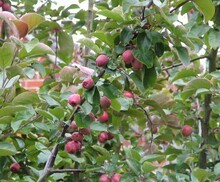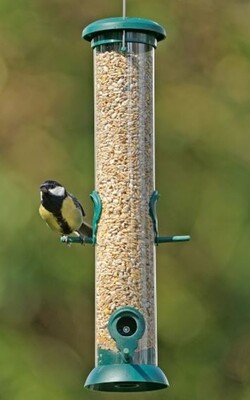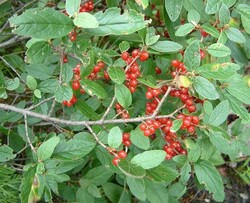Fruit Tree Removal on Public Lands
We are taking action to make our community safer for people and wildlife.
Fruit trees attract hungry bears which puts our community at risk. Bear accessing fruit trees in residential areas is one of the main reasons for a bear being relocated or killed.
We are leading by example by removing fruit trees on public land, including parks and road rights-of-ways. Crews will begin surveying priority areas in Spring 2024. If tree removal is required adjacent to your property, we will inform you by mail.
You can make a difference for wildlife.

Berry bushes and fruit trees can attract bears into residential areas, putting wildlife and people at risk. Ornamental crab-apple, chokecherry, and mountain ash trees, as well as buffalo berry are common trees and bushes found in Canmore that are known to provide a lot of food and calories for bears.
The more bears visit urban areas with fruit trees and bushes, the more the bears learn where to find this easy food source. This means the bears are “food-conditioned” and are now used to being around humans. This is a public safety concern, which often results in wildlife managers having to destroy or translocate bears from the community.
The Community Standards Bylaw is designed to increase public safety, reduce negative human-wildlife interactions, reduce nuisances caused by wildlife entering the community, and enables our peace officers to address these issues if and when they arise.
- It is against the law to let fruit or berries accumulate on trees, bushes, or the ground
- That you can’t plant new fruit bearing trees or bushes in your yard in Canmore
- Fines for letting fruit accumulate on trees and bushes or planting new trees and bushes can range between $1,000 - $10,000.
What You Can Do
- Remove the fruit trees or bushes from your property – see Fruit Tree Removal Incentive Program details.
- If you can’t remove the tree, it is your responsibility to remove the fruit as soon as it begins to ripen and bring it indoors or properly dispose of it in a bear proof food waste bin, located throughout the community. The collected fruit will be composted.
- Fruit-picking equipment can be borrowed from Wildsmart; please contact them at info@wildsmart.ca to make arrangements to borrow the equipment.

Bird feeders are ONLY allowed in our community from Dec. 1 until March 31. We recommend suspending the bird feeder on a cable, so that it can’t be reached by any other wildlife, and remember to clean the ground underneath.
Do not use bird feeders of any kind during bear season (April 1 to Nov. 30) - it's the law, and you could face a minimum fine of $250. With bears waking up, bird feeders can attract hungry bears into neighbourhoods which puts our community at risk. Bears that access food could injure or kill people or pets and may need to be relocated or killed. Prevent wildlife from accessing any food on your property, including garbage, bird feeders, and fruit trees.

Buffalo berry grows along the edges of open areas which often include pathways, meadows, edges of residential areas, water bodies, and also can be present in our yards – essentially areas where humans live and play. In the Bow Valley, the berry season usually runs from mid-July until the end of August. Bears are attracted to this plentiful shrub and will eat tens of thousands of berries each day to store energy for their upcoming hibernation.
The Town of Canmore and the Province of Alberta are trying to keep both the bears and residents safe by removing buffalo berry bushes from high human-use areas. Some areas include Rundleview, Quarry Lake, Three Sisters Campground, Bow River Campground, and along trails in the Canmore Nordic Centre and at Grassi Lakes Trail.
Many residences also have buffaloberry growing in their backyards and gardens. These bushes become a prime attraction to bears, especially in residential areas adjacent to the wildland fringe. Bears feeding in private yards create a public safety concern. Residents can be WildSmart by learning how to identify buffalo berry bushes and remove them from their own property. For more information and to learn how to identify these plants, visit: wildsmart.ca
Feral rabbits in Canmore are domesticated pets that were inappropriately released. They are not native wildlife species.
Feral rabbits are a wildlife attractant and population control is an issue. Short gestation periods and large litters can mean that the population can grow from 2 to 70 within one year. In addition, they cause damage to public and private property and leave a significant amount of feces.
The Town of Canmore's Feral Rabbit Management Program hires a contractor to live trap, humanely euthanize, and store and transport the rabbits to beneficial end-use (such as feed at wildlife rehabilitation centers). The contractor may also provide assistance to residents who request assistance with removing feral rabbits from private property. The goal is to control and ultimately eliminate feral rabbits from the Town of Canmore.
The program is most effective when trapping occurs on both public and private property. If you have rabbits in your area, please consider signing up to allow trapping on your property. Property owners who want the contractor to remove feral rabbits from their property need to fill out this private property access agreement form: Private Property Access Agreement. If you have submitted the form in previous years, simply email feralrabbits@canmore.ca to reconfirm your permission to continue trapping.
Once you've filled out the form, please e-mail it to feralrabbits@canmore.ca
Please note if you are a renter the request needs to come from the property owner.
Rabbit Hemorrhagic Disease
Canmore has its first case of Rabbit Hemorrhagic Disease (RHD), which was verified by a PCR test by a lab at the University of Calgary. Another sample submitted to the lab showed favorably for RHD in the preliminary test. It is highly likely that the disease is spreading through Canmore's feral rabbit population.
Although it poses no risk to human health, RHD is a sudden, highly contagious and fatal viral disease that affects both domesticated and wild rabbits. Many times, the only signs of the disease are sudden death and blood-stained noses caused by internal bleeding. '
How is Rabbit Hemorrhagic Disease (RHD) Spread?
RHD outbreaks move rapidly through rabbit populations. In most cases, the virus kills such a high proportion of feral rabbits that the virus will disappear in the outbreak area. RHD can be spread through direct contact or exposure to an infected rabbit’s excretions or blood.
The virus can also survive and spread from carcasses, food, water, and any contaminated materials. People can spread the virus indirectly by carrying it on their clothing and shoes.
RHD poses risks to wild rabbits as a result of sharing time and space with feral rabbits. To date, there has been spillover of RHD in wild rabbits and hares across parts of the western United States, but we have not yet seen this spillover in Alberta.
What Do I Do if I See a Dead Rabbit?
If you see a dead feral rabbit, the carcass can be cleaned up to minimize environmental contamination by being placed inside two plastic bags and disposed of in a bear-proof garbage bin. Personal protective equipment, like gloves, should be used when handling a carcass.
Residents may also call Municipal Enforcement to help with the removal of a carcass or carcasses.
If you see a dead wild rabbit, contact Municipal Enforcement at rabbits@canmore.ca
Where Can I Learn More About RHD?
